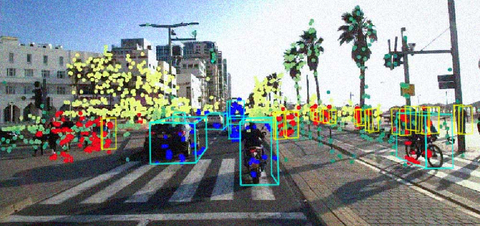Automotive-grade, in-house developed imaging radars targeted for production in two years.
Over the past few years, Mobileye has been developing a new technology to help autonomous vehicles sense and understand their environment – regardless of weather, lighting or road types – in addition to the company’s renowned camera-based perception systems. Known as software-defined imaging radar, or 4D radar, the technology will play a key role in bringing autonomous vehicles and the most advanced forms of driver-assistance technology to life.
This press release features multimedia. View the full release here: https://www.businesswire.com/news/home/20230104005343/en/

Mobileye’s imaging radar supports other key AV vision sensors, and can detect objects, vehicles and pedestrians at distances of up to 1,000 feet. Illustration: Mobileye.
Today, Mobileye announced a collaboration with Wistron NeWeb Corp. (WNC) for production of its software-defined imaging radars. WNC, based in Taiwan, works as a major electronics and radar supplier for automakers worldwide. This collaboration is expected to allow Mobileye and WNC to begin producing automotive-grade imaging radars two years from now, with strong initial interest in the technology from key automaker customers.
“The imaging radars we have been developing over the past few years are uniquely designed to be an essential enabler of high autonomy levels in future vehicles, by delivering rich and reliable radar output, upgrading perception-by-radar capabilities, and reducing the need for multiple lidar sensors,” said Yaniv Avital, Mobileye’s Radar Vice President and General Manager. “WNC’s experience and accomplishments as an automotive supplier can help us bring this much-needed innovation to the market by our original targeted timeline and at the expected quality.”
The imaging radar developed by Mobileye goes far beyond the simple devices on vehicles today. Radars emit radio frequency signals to detect obstacles, and just like cameras, the more data they can process, the more details they can spot. When paired with advanced cameras, radars can provide sensing at longer distances and in certain weather or lighting conditions that can even challenge camera-based imaging.
Mobileye’s imaging radars use advanced radar architecture including Massive MIMO (multiple-input, multiple-output) antenna design, a high-end radio frequency design developed in-house, and high-fidelity sampling – all enabling accurate object detection and wider dynamic range. Thanks to an integrated system-on-chip design that maximizes processor efficiency, and world-leading algorithms for interpreting radar data, Mobileye’s imaging radars deliver a detailed, four-dimensional image of surroundings up to 1,000 feet away and beyond. With a 140-degree field-of-view at medium range and 170-degree field of view in close range, the radar enables more accurate detection of pedestrians, vehicles or obstructions that other sensors might miss – even on crowded urban streets.
“The new imaging radar technology is a key focus for future high-level autonomous driving,” said Repus Hsiung, Vice President & General Manager of the Automotive & Industrial Solutions BG at WNC. "We are delighted to collaborate with Mobileye to accelerate the availability of advanced imaging radars in the market. Leveraging our expertise in automotive electronics and radar solutions, we look forward to working with Mobileye to further develop exciting new capabilities.”
Mobileye’s True Redundancy™ approach to autonomous vehicles envisions using imaging radars to create a 360-degree sensing system that operates in addition to, but independently from, a camera-based system. By having multiple systems that are each capable of navigating a vehicle alone, the “eyes off” autonomous system can deliver reliable rides with low chance of failure and simplified safety validation. Imaging radar can also play a role in more advanced hands-free ADAS solutions as an alternative to LiDAR solutions, which are typically far more expensive.
___________________________________
Mobileye (Nasdaq: MBLY) leads the mobility revolution with its autonomous driving and driver-assistance technologies, harnessing world-renowned expertise in computer vision, artificial intelligence, mapping, and data analysis. Since its founding in 1999, Mobileye has pioneered such groundbreaking technologies as REM™ crowdsourced mapping, True Redundancy™ sensing, and Responsibility Sensitive Safety (RSS). These technologies are driving the ADAS and AV fields towards the future of mobility – enabling self-driving vehicles and mobility solutions, powering industry-leading advanced driver-assistance systems and delivering valuable intelligence to optimize mobility infrastructure. To date, more than 125 million vehicles worldwide have been built with Mobileye technology inside. In 2022 Mobileye listed as an independent company separate from Intel (Nasdaq: INTC), which retains majority ownership. For more information, visit https://www.mobileye.com.
“Mobileye,” the Mobileye logo and Mobileye product names are registered trademarks of Mobileye in various jurisdictions. All other marks are the property of their respective owners.
View source version on businesswire.com: https://www.businesswire.com/news/home/20230104005343/en/
Contacts
Justin Hyde
Justin.Hyde@Mobileye.com
(202) 656-6479













